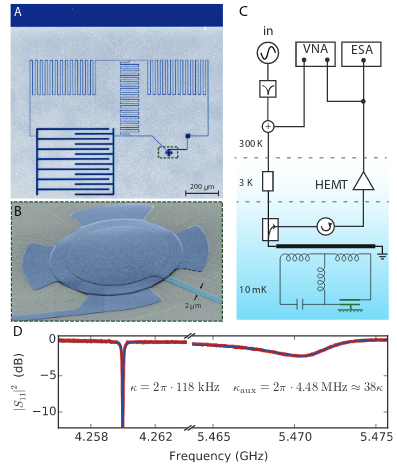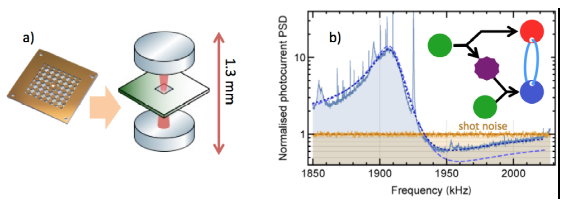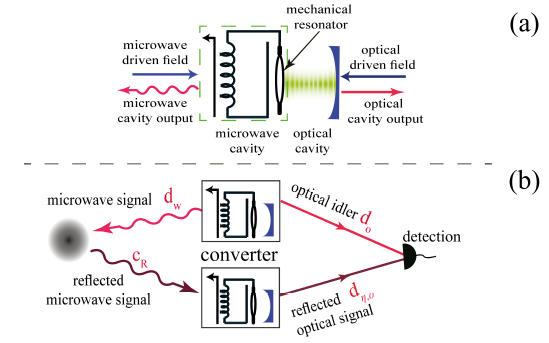HIGHLIGHTS
Third year
 |
1) Non-classical correlations between single photons and phonons from a mechanical oscillator UNIVIE operated an optomechanical crystal structure (mechanical resonance frequency ωm/2π = 5.3 GHz, mechanical quality factor Qm = 1.1 × 106, cavity decay rate κ/2π = 1.3 GHz, single-photon coupling strength g0/2π = 825 kHz) in a dilution refrigerator. The mechanical oscillator was first initialized in its mechanical ground state by cryogenic cooling. The resulting mechanical occupation number was evaluated by sideband thermometry, yielding a value of nm=0.025, showing that the mechanical oscillator was deep in the quantum ground state. In a second step, a short light pulse blue-detuned with respect to the cavity resonance (the “write pulse”) was used to create a photon—phonon pair with a probability of approximately 3%. In a third step, a red-detuned light pulse (the “read pulse”) was used to drive a phonon-to-photon conversion, effectively swapping the quantum state from the mechanical oscillator onto the light field. To demonstrate that this protocol can be operated in a fully quantum-coherent manner, the output light from both pulses has been used to measure the cross-correlation function g(2). The observed violation of a Cauchy–Schwarz inequality obeyed by g(2) for classical light, is clear evidence for the non-classical nature of the mechanical state generated. Our results demonstrate the availability of on-chip solid-state mechanical resonators as light–matter quantum interfaces. The performance we achieved will enable studies of macroscopic quantum phenomena as well as applications in quantum communication, as quantum memories, and as quantum transducers. |
 |
2) A dissipative quantum reservoir for microwave light using a mechanical oscillator Isolation of a system from its environment is often desirable, but dissipation can also be a useful resource. In the field of cavity electro- and optomechanics, the control over mechanical oscillators down to the quantum regime is achieved by engineering the coupling with the inherently cold, dissipative nature of the electromagnetic degree of freedom. Breaking from this paradigm, recent theoretical work has considered the opposite regime in which the dissipation of the mechanical oscillator dominates and provides a cold, dissipative reservoir to an electromagnetic mode. EPFL has implemented this reversed dissipation regime in a microwave cavity optomechanical system and realized a quasi-instantaneous, cold reservoir for microwave light. Coupling to this reservoir enables to manipulate the susceptibility of the microwave cavity, corresponding to dynamical backaction control of the microwave field. Additionally, we observe the onset of parametric instability, i.e. the stimulated emission of microwaves (masing). Equally important, the reservoir can function as a useful quantum resource. We evidence this by employing the engineered cold reservoir to implement a large gain (above 40 dB) phase preserving microwave amplifier that operates 0.87 quanta above the limit of added noise imposed by quantum mechanics. Such a dissipative cold reservoir forms the basis of microwave entanglement schemes, the study of dissipative quantum phase transitions, amplifiers with unlimited gain-bandwidth product and non-reciprocal devices, thereby extending the available toolbox of quantum-limited microwave manipulation techniques. |
 |
3) Multimode optomechanical system in the quantum regime UCPH has realized a simple and robust optomechanical system with a multitude of long-lived (Q > 107) mechanical modes in a phononic-bandgap shielded membrane resonator. An optical mode of a compact Fabry–Perot resonator detects these modes’ motion with a measurement rate (96 kHz) that exceeds the mechanical decoherence rates already at moderate cryogenic temperatures (10 K). Reaching this quantum regime entails, inter alia, quantum measurement backaction exceeding thermal forces and thus strong optomechanical quantum correlations. In particular, we observe ponderomotive squeezing of the output light mediated by a multitude of mechanical resonator modes, with quantum noise suppression up to −2.4 dB (−3.6 dB if corrected for detection losses) and bandwidths ≲90 kHz. The multimode nature of the membrane and Fabry–Perot resonators will allow multimode entanglement involving electromagnetic, mechanical, and spin degrees of freedom. |
Second year
 |
1) Optimal state estimation and detection of optomechanical correlations UNIVIE and LUH have implemented a Kalman filter, which is a well-known technique from classical estimation theory, based on an accurate model of the experimental setup (in our case including coloured amplitude and phase noise of the laser, photon losses, and multiple auxiliary mechanical modes). It produces the least-square-error estimates of the optical and mechanical dynamical variables. In the experiment we monitored the real time trajectories, and consequently also the correlations between the optical phase quadrature and the mechanical position, created by driving the optomechanical system with a red-detuned laser drive. Increasing the optomechanical coupling strength from the weak to the strong coupling regime results in the creation of strong optomechanical correlations. In order to verify the accuracy of the used model, we conducted an extensive statistical analysis of the innovation sequence, i.e., the difference between predicted and actual measurements. |
 |
2) Demonstration of single-photon cavity optomechanics mediated by a quantum two-level system AALTO node has designed and demonstrated an optomechanical setup in the microwave frequency regime involving a Josephson junction qubit. In particular we demonstrate boosting of the radiation–pressure interaction by six orders of magnitude, allowing to approach the strong coupling regime. We observe nonlinear phenomena at single-photon energies, such as an enhanced damping attributed to the qubit. This work opens up nonlinear cavity optomechanics as a plausible tool for the study of quantum properties of motion. |
|
|
Quantum illumination consists in the detection of a distant target in the regime of large noise and very weak signals. In fact, it is known that entangled light can outperform the optimal classical target detection strategy based on sending coherent signals. UNICAM node has developed a realistic scheme in the microwave domain which is the natural scenario for large noise – weak signal regime. The key element is just a mechanical resonator interface, simultaneously coupled to driven optical and microwave modes, which must be used twice: i) for generating hybrid optical-microwave two mode squeezed radiation as the necessary probing light; ii) for high-fidelity upconversion of the weak return microwave signal into an optical signal which can be then measured with a photodetector, realizing a phase-conjugated receiver. See also Physics coverage article |
First year
 |
1) Optical detection of radio waves through a nanomechanical transducer Very important result by the UCPH node, which has been published in Nature. The radio-frequency signals are detected as an optical phase shift with quantum-limited sensitivity. This performance competes with current state-of-the-art operational amplifiers at room temperature and it can be improved with further advances. The device will be of interest in sensing applications (NMR, radio astronomy etc.) where it is coupled to a cold signal input and the Johnson noise is strongly suppressed. Compared to existing detectors, this approach has the advantage of working at room temperature, and the signals produced can be readily transferred into standard optical fibres (see also the News&Views comment by the AALTO partner) See also Physics World and Scientific American coverage articles |
 |
2) Graphene optomechanics and sideband cooling at microwave frequencies The first experimental demonstration of a graphene-based electromechanical resonator, by the AALTO node, in which a graphene flake is capacitively coupled to a microwave cavity. Such a coupling has been used for sideband cooling the mechanical motion down to n = 40 thermal quanta, which is the lower phonon occupation recorded to date with graphene resonators. |
 |
3) Quantum limited microwave amplification in the reversed dissipation regime Proposal for quantum-limited amplification and parametric instability in the reversed dissipation regime of cavity optomechanics, in which a damped mechanical oscillator can be used to cool or amplify a microwave cavity; such a study opens a practical way to achieve a quantum-limited optomechanical amplifier with a large gain-bandwidth product complementing phase-sensitive amplifiers based on superconducting Josephson junctions. |
 |
4) High-Q InGaP membranes for strong coupling optomechanics Design and fabrication of novel InGaP nanomembranes, which are particularly suited for the integration in opto-electro-mechanical systems, and which have shown very high mechanical quality factors. |








